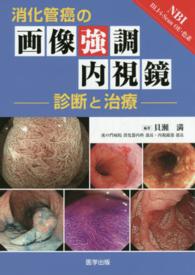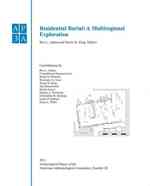- ホーム
- > 洋書
- > 英文書
- > Science / Mathematics
Contents
Block One:
Brief history of PCR and DNA sequencing techniques, and their roles in advancing molecular biology and life science at large; the guiding principles and objectives of the book.
Chapter I. General Introduction
a.) A short history in PCR and DNA sequencing techniques
b.) Landmark molecular biology and life science advancement resulted from DNA sequencing and PCR techniques
Chapter II. Guiding principle and organization of the book
a.) Purpose, Objective, Scope
b.) Intended audience
c.) Flow and logic of the book
d.) Inclusions and exclusions, limitations
Block Two:
Chapters three through five will first describe the current broadly used next generation sequencing platforms, PCR instrument application, followed by a comparative overview of their utilities and applications, particularly in microorganism genomic analysis.
Chapter III. Next Generation Sequencing Principles and Platform
a.) Principle chemistry: sequencing by ligation
b.) Principle chemistry: sequencing by synthesis
c.) Leading NGS platforms
i. Ion Torrent PGM (Personal Genome Machine)
ii. Illumina HiSeq and MiSeq
iii. PacBio (Pacific Biosciences) RSII
iv. Other platforms: SOLiD, illumina GA (Genome Analyzer)
d.) Technical specifications to targeted utilities
Chapter IV. PCR instrument and applications in NGS
a.) Principles and instrument
b.) Basic chemistries
c.) Utility of NGS
Chapter V. Overview of utilities and comparative application
a.) Targeted analytic requirements
b.) Source material determination
c.) Microorganism genome sequencing
d.) Genome sequencing
e.) Transcriptome sequencing
f.) Chromatin immunoprecipitation sequencing
g.) Metagenome sequencing
h.) Epigenomic variation analysis
Block Three:
Chapters six through ten describe the sequencing methodologies using each type of the NGS instruments, selection of platforms and reagent kits for targeted applications, metagenomic sequencing, single cell sequencing, epigenetic analysis, procedure modification for adaptation and optimization, and sample specific treatment. These chapters will also discuss workflow logic, sequencing chemistry, selection of methodologies, system errors and errors generated by other causes.
Chapter VI. Methodologies
a.) Source material specific sample preparation
i. Infectious material inactivation
ii. Chemical and physical approaches
iii. Storage
b.) DNA/RNA Extraction
i. Instrument specification evaluation
--Quantity estimate (amount)
--Quality evaluation (fragment length)
ii. DNA extraction quality control
--Concentration measurement
--Quality evaluation
iii. RNA extraction quality control
--Concentration measurement
--Quality and sizing evaluation
c.) NGs cDNA Library Prep
i. Amplification-based library preparation
ii. Amplification-free library preparation
iii. DNA fragmentation
iv. Enzymatic treatment for DNA repair
v. Poly-A tailing of fragment
vi. Library validation
Chapter VII. NGS Platform specific operational protocols
a.) Illumina
i. cDNA Library preparation from DNA extraction
--DNA fragmentation
--Adapter ligation
--PCR enrichment
--Comparison of commercial kits
ii. cDNA library preparation from RNA extraction
--mRNA selection
--polyA tail selection
--ribosome RNA removal
--DNA Fragmentation
--cDNA synthesis
--Ligation of adapters
--PCR enrichment
iii. Library validation
--Concentration measurement
--Sizing estimate
--Sequenceable concentration estimation
iv. Sequencing
--Instrument dependent condition
--Read lengths, number of reads and time requirement
b.) PacBio
i. DNA extraction
ii. Source material specific notation
iii. Library preparation of 10Kb template
--DNA Fragmentation
--Insert size determination
--Repair of DNA damage
--Repair of insert ends
--Blunt ligation
--Inactivation of ligate
--Digest of misligate product
c.) Library preparation of 20Kb template
--Fragmentation of DNA
--Insert size determination
--Repair of DNA damage
--Insert ends repair
--Blunt ligation
--Inactivation of ligate
--Digest of misligate product
--Size selection
d.) Sequencing primer annealing
e.) Binding Reaction
f.) Sequencing
--Binding of DNA polymerase to SMRT template
iii. Ion Torrent PGM, Ion Proton
--Library preparation
--Emulsion PCR
--Enrichment
--Quality control
--Sequencing
vii. SOLiD
Chapter VIII. Choice of platform and reagent kit selection
a.) Platform specific considerations
i. Nucleic acid quality
ii. Quantity availability
iii. Read number requirement
iv. Read length requirement
v. Time
vi. Sequencing cost per Gb
b.) Sample Source material based selection
i. Microbial isolates, viral samples, animal, human, plant, environmental
ii. Formalin-fixed, paraffin-embedded samples
iii. Trace amount analysis
iv. Metagenomic
v. Single cell
c.) Research objective based selection
d.) Throughput based consideration
Chapter IX. Targeted application areas
a.) SNP analysis from draft sequencing output
b.) Large scale small RNA study
c.) Landscape of human genome research
d.) Forensics application
Chapter X. Enhancement and Optimization
a.) Barcoding, multiplexing
b.) Fragment sizing
c.) Kit selection and modification
Block Four:
Chapter eleven provides a prospect of future generations of techniques near release and coming into horizon.
Chapter XI. Future techniques
a.) Close to release: Oxford Nanopore
b.) In the horizon: Thumb-drive sequencer
c.) Prospect
Appendices:
Citations
Referencess
Notes








